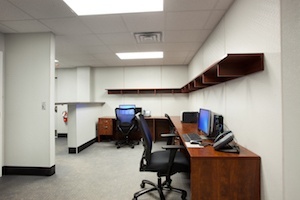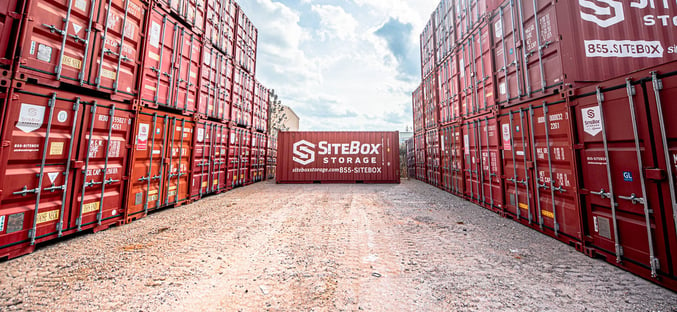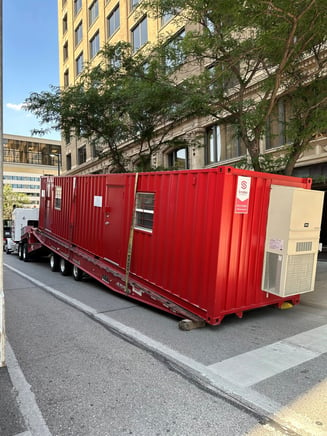smart medical storage solutions for healthcare facilities

Hospitals overrun with patients are also overrun with stuff. There's not enough room. Portable storage facilities are solving this problem right now.
About 75% of healthcare providers use electronic medical records, but physical documents haven't disappeared. The global portable medical storage market is hitting $12.8 billion by 2026 because healthcare facilities are figuring out flexible storage actually works.
Why Medical Records Storage Matters
Medical records contain sensitive patient information needing protection, organization, and immediate access. HIPAA compliance isn't optional. Screw up and you're looking at massive fines and legal problems.
Nearly 90% of medical professionals say portable record storage improves patient care efficiency. When charts are organized and accessible instead of buried somewhere, everyone can do their jobs better.
The challenge is balancing security with accessibility. Records need to be close enough for quick access but secure enough that unauthorized people can't get near them.
Types of Portable Storage Solutions for Healthcare
Basic storage containers are solid steel boxes with lockable doors. Weatherproof and secure for supplies and archived records.
Mobile offices give you workspace plus storage with shelving units, workstations, and climate control. Perfect for active medical records staff access daily.
Combination units split the difference—half workspace, half storage. Common at temporary clinics and vaccination sites.

Specialized units include climate control for sensitive items, reinforced shelving, and custom layouts. Sizes range from 10-foot to 40-foot containers.
Compliance with Healthcare Regulations and Standards
HIPAA compliance requires physical security for personal health information. Portable storage helps by creating secure areas accessed only by authorized staff. Solid steel construction keeps unauthorized people out.
Records storage needs environmental protection too. Fire-resistant materials, climate control preventing humidity damage, and pest protection all matter for compliance.
Document who accesses records and when. Some mobile offices include tracking systems. At minimum, you need locks limiting access and a process monitoring who's going in and out.

State and local regulations vary. Check what applies to your location regarding retention periods, security measures, and disposal requirements.
Best Practices for Organizing Medical Records
Use a consistent filing system—alphabetical, numerical, or date-based. Stick with it. Color-coded folders and labels help staff identify record types fast.
Shelving units designed for filing make a huge difference. Adjustable shelves accommodate different folder sizes. Label everything clearly.
Separate active records from archives. Daily-use stuff stays at eye level. Archives go higher or lower.
Keep a database tracking what's in storage and where. Staff can look up locations instead of searching randomly.
Choosing the Right Portable Storage Unit
Measure what you're storing. Count filing cabinets, shelves, boxes, equipment. Pick a unit with 20% extra room for growth.

Climate control is critical for paper records and temperature-sensitive items. Get HVAC-equipped units if storing anything sensitive.
Security features vary. Basic containers have lockable doors. Upgraded units offer reinforced locks, cameras, motion sensors. Think about what your compliance requirements need.
Layout options include open storage, divided sections, or office configurations. Figure out what your team needs.
Security Measures for Protecting Medical Records
Steel construction resists break-ins. Reinforced doors and commercial-grade locks are worth paying for.
Limit access with keys only to authorized staff. Consider keypad locks where you can change codes and track entry. Security cameras deter theft and provide records of access.
Store units in visible, well-lit locations near building entrances or regular foot traffic. Avoid dark corners.
Lock filing cabinets inside the storage unit for double protection. Don't leave sensitive documents laying around.
Digital vs Physical Storage Options
Electronic medical records are huge—75% of healthcare providers use them. Cloud solutions offer secure access anywhere. About 30% of organizations use cloud storage, and 58% of patients want mobile access to their records.
But digital doesn't eliminate physical storage. You've got older records never digitized, consent forms with actual signatures, legal documents requiring originals, test results with images or specimens.
Most healthcare facilities run hybrid systems. Digital for newer records and frequent access. Physical storage for archives, legal documents, and supplies. Portable storage handles the physical stuff while electronic systems cover the digital side.
Backup matters for both. Digital needs redundant systems and encryption. Physical needs secure storage protecting against fire, water, theft, and deterioration.
Benefits of Mobile Medical Record Storage
Convenience tops the list. Storage right outside your door means records are never far. No driving across town to off-site facilities. Walk outside, grab what you need, walk back. Saves hours every week.

Flexibility helps during changes. Expanding? Renovating? Add portable storage immediately. Need it elsewhere later? Move it.
Cost beats building permanent additions. Construction is expensive and slow. Portable storage gives you space now at a fraction of the cost.
Modular design means you scale easily. Add units as you grow. Remove them when needs change.
Disaster Recovery Planning
COVID showed how critical portable storage is during emergencies. Units served as mobile testing sites, PPE storage, temporary offices, and overflow for supplies.
But disaster planning goes beyond pandemics. Fires, floods, power outages—lots of things can shut down your main facility. Having portable storage means you can secure critical records and continue operations.
Store backup copies of essential records in portable units separate from your main facility. Keep emergency supplies and critical medications protected but accessible.
The portability itself is the advantage. If you need to evacuate or relocate, mobile units move with you.
Cost Considerations and Budgeting
Pricing varies based on size and features. Basic containers start around a few hundred monthly for rent. Equipped mobile offices with HVAC cost more. Custom configurations add to the price.
Buying makes sense for permanent needs. Purchase prices range from several thousand to $50,000+ for customized units. Spread across years of use, ownership often beats renting long-term.
Factor in delivery, setup, and site prep. Don't forget ongoing expenses like insurance, maintenance, utilities, and permits. Budget for the complete picture.
The ROI shows up in efficiency, security, and space optimization. When your team wastes less time and theft decreases, the investment pays for itself.
Setting Up Your Portable Medical Storage
Choose locations accessible to staff but not overly exposed for security. Near building entrances works well.
Ground preparation ensures stability. Level surfaces prevent doors from binding. Concrete pads work best for permanent placements.
Interior setup requires planning. Install shelving before filling the space. Arrange filing cabinets logically. Create zones for different record types.
Climate control installation maintains consistent temperature and humidity. Security installation includes locks, cameras, lighting, and alarms. Do this before storing valuable items.
Maintenance and Long-Term Care
Check door seals and locks monthly. Look for rust or damage. Inspect roofs after storms. Keep drainage clear.
Climate control systems need maintenance like any HVAC. Change filters regularly. Have systems serviced annually.
Keep the interior organized. Don't let it become a dumping ground. Maintain your filing system. Remove items you no longer need.
Pest control matters. Seal gaps. Don't store food. Check for signs of pests and address immediately.
Document your inventory. Track what's in storage and when items move.
Real-World Applications in Healthcare
Medical records storage is obvious, but healthcare facilities use portable storage for tons of things. PPE, supplies, equipment all need secure accessible storage.
Mobile clinics use converted containers as complete medical facilities. You see these at public events, rural areas, disaster relief operations, and vaccination sites.
Administrative offices at construction sites for new healthcare facilities use mobile offices. Staff can work on-site during building projects.
Renovation projects need temporary storage for displaced items. Testing and triage during emergencies, like COVID testing sites, use portable units to keep potentially contagious patients separated.
Frequently Asked Questions
What are the best portable storage options for medical records? Steel storage containers with climate control work best for medical records. Look for units with shelving systems, lockable doors, and HVAC to protect against temperature and humidity damage. Mobile offices converted for records storage include workspace for staff.
How do I safely transport medical records? Use locked boxes or filing cabinets inside the portable unit during transport. Secure everything so items don't shift. Maintain chain of custody documentation. Only authorized personnel should handle transport. Climate-controlled vehicles prevent damage during moves.
What materials should my portable storage be made of? Steel construction offers best security and durability for healthcare storage. Look for weather-resistant materials, fire-resistant options where possible, and reinforced doors. Avoid wood structures for medical records storage due to pest and moisture concerns.
Are there specific requirements for storing medical records? HIPAA requires physical security, access controls, and protection of personal health information. State regulations vary on retention periods and disposal methods. Records must be protected from unauthorized access, environmental damage, and loss. Check federal and local requirements for your location.
How can I ensure confidentiality while using portable storage? Limit access with quality locks and key control. Use surveillance cameras. Store units in secure, monitored locations. Lock filing cabinets inside the storage unit. Track who accesses records and when. Train staff on confidentiality requirements.
What size should a portable storage solution be for medical records? Depends on volume. A 10-foot container holds roughly 5-7 standard filing cabinets plus some supplies. A 20-foot unit accommodates 12-15 cabinets. A 40-foot container can hold 25-30 filing cabinets or equivalent boxes. Measure what you have and add room for growth.
Is climate control necessary for portable medical record storage? Yes, for paper records. Extreme temperatures and humidity damage documents over time. Climate control maintains consistent conditions that prevent deterioration. Essential for long-term storage and compliance with preservation requirements.
What are the costs associated with portable storage solutions? Rental averages $200-$500 monthly depending on size and features. Climate-controlled units cost more. Purchase prices range from $8,000-$50,000+ based on size and customization. Add delivery, setup, insurance, and maintenance to your budget.
Can I use regular filing cabinets for portable medical records? Yes, standard filing cabinets work fine inside portable storage units. Lock them for added security. Use lateral or vertical file cabinets based on your space. Heavy-duty commercial cabinets designed for medical offices work best for durability and organization.
What security features should I look for in portable storage? Reinforced steel doors with commercial-grade locks. Keypad or coded entry systems. Security cameras with recording capability. Motion-sensor lighting. Tamper-resistant hardware. Weather seals that prevent unauthorized entry. Consider alarm systems for high-value or sensitive storage.
Making the Right Choice for Your Healthcare Facility
Healthcare facilities are busting at the seams. Portable storage gives you space, security, and flexibility without the massive cost of permanent construction.
Whether storing medical records, supplies, or equipment, these units adapt to what you need. Healthcare providers seeing the best results plan ahead, choose quality units, and set up proper organization from the start.
Think about your challenges. Where are you cramped? What's poorly organized? What security issues keep you up at night? Portable storage probably solves some of those problems.
Contact companies that understand healthcare needs. Ask about compliance, security features, and customization. Get pricing for your situation. The investment pays off through efficiency, security, and peace of mind.
Contact a representative today to learn more about the portable storage options available at SiteBox Storage.




